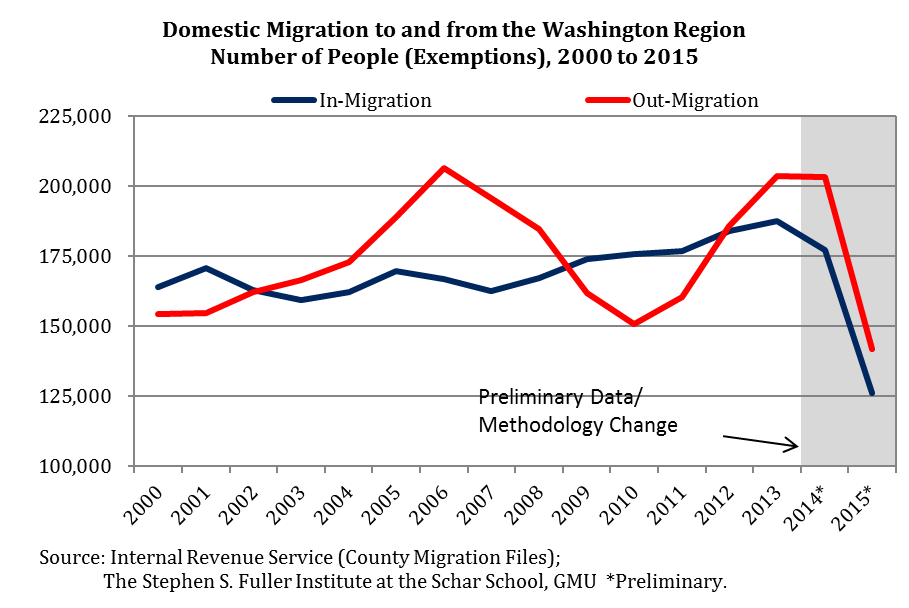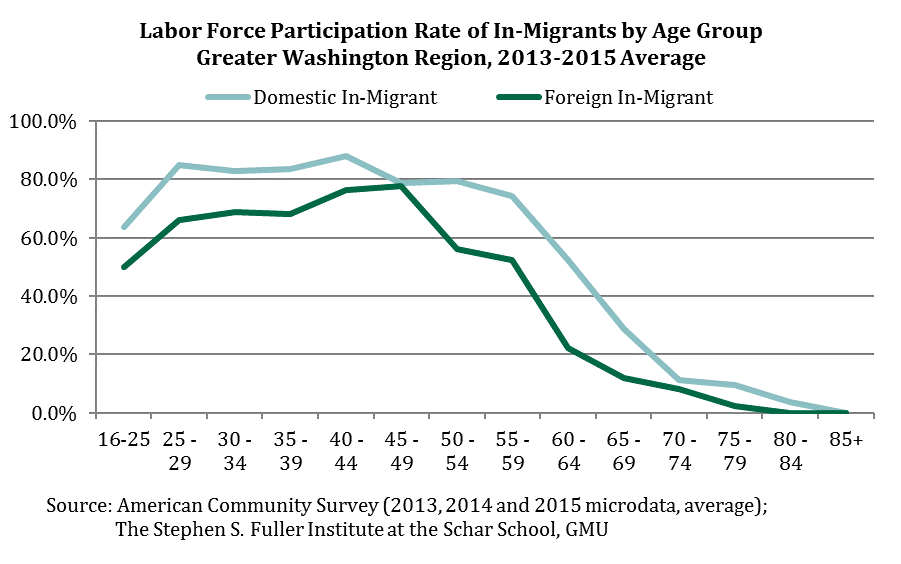The below is a summary of Migration in the Washington Region: Trends between 2000 and 2015 and Characteristics of Recent Migrants.
View Full Report as PDF ›
View Executive Summary as PDF ›
Between 2000 and 2016, the population in the Washington region increased from 4.86 million people to 6.13 million people. This change was the result of three factors: the natural increase (births minus deaths), net domestic migration, and net foreign migration. During this period, population gains occurred from the natural increase and net foreign migration while the region lost population from net domestic migration.
Population growth that results from the natural increase is relatively predictable and primarily based on an individual’s life cycle. As such, the patterns over time and the characteristics of new residents (babies) are stable and depend upon the characteristics of current residents. By contrast, migration is more dependent upon external factors, like economic opportunity, cost of living, and quality of life. These factors change, both in the Washington region and elsewhere, resulting in differing patterns over time.
Domestic Migration
Net domestic migration consists of the number of people moving to the Washington region from elsewhere in the U.S. (inflows) and the number of people moving out of the Washington region to elsewhere in the U.S. (outflows). Net domestic migration in the Washington region resulted in population losses during the 2000-2015 period, overall, but was positive during two periods: 2000-2002 and 2009-2011.
During the periods of population gains from net domestic migration, the number of residents leaving the Washington region decreased, but the number of residents moving to the Washington region was stable. Positive net domestic migration reflected periods when the region was better able to retain its existing residents, not periods when the region became more attractive to new potential in-migrants. Decreased domestic outflows also corresponded with periods when the region’s job growth outperformed the growth in the rest of the nation and job growth in the rest of the nation was either negative or following a downward trajectory.

Combined, this suggests that the region’s ability to retain existing residents was dependent upon economic factors. However, its ability to attract new residents was less tied to shifts in economic conditions and may be more dependent upon the overall level of economic opportunity in the Washington region. Other findings in this report support that conclusion:
- The Washington region lost population to metros with relatively strong job growth, to metros close the region with lower costs of living, and to metros that are typically attractive to retirees.
- The Washington region gained population from a geographically dispersed set of metros that had lagging economic growth, smaller economies or higher costs of living.
- In-migrants were more likely to be younger, highly educated and employed in higher wage sectors including Professional, Scientific, & Technical Services & Management and the Federal Government.
- Out-migrants were more likely to be of retirement age, not employed or employed in lower wage sectors of Retail Trade and Leisure & Hospitality.
Domestic in-migration was a key source for new residents and workers in the Washington region, but out-migration flows resulted in net losses. These losses were a result of accelerated outflows during periods of strong national employment growth that likely provided more options for residents in the region who may have been looking to leave for either work or retirement.
Foreign Migration
Net foreign migration consists of the number of people moving to the Washington region from abroad (inflows) and the number of people moving out of the Washington region to places outside of the U.S. (outflows). Net foreign migration in the Washington region was stable between 2000 and 2015 and resulted in net population gains during every year of the period. These gains were the result of relatively small inflows and outflows, which were also stable over this period. Foreign migration patterns seem to be less affected by regional economic trends and the modest variation in flows is likely tied to national and international trends.
Overall, foreign in-migrants to the greater Washington region fell into two categories:
- U.S.-born in-migrants, those born in the U.S., who were somewhat older and more likely to be employed by the Federal Government as compared to domestic in-migrants, and
- foreign-born in-migrants who were more likely to be older, less educated, and less attached to the labor force.
U.S.-born in-migrants tended to have higher labor force participation rates than those born abroad, but the overall rates fell far below that of domestic in-migrants. Foreign in-migrants of every age group were less likely to be employed or looking for a job compared to domestic in-migrants.

Even though net foreign in-migration was an important source of population growth for the Washington region, it has had a significantly smaller impact on the region’s workforce. Foreign migration inflows and outflows were also less sensitive to changes in the region’s job growth.
Future Implications
As the Washington region enters a period of economic uncertainty, domestic out-migration is likely to accelerate as it has in the past, with future out-migration driven in part by the retirement of the Baby Boomers. Domestic in-migration was steady during the 2000-2015 period but weaker economic growth, diminishing quality of life, and a smaller Generation Z may subdue future inflows.
The Washington region’s reliance on the natural increase, which results in babies, and foreign migration for population growth will likely continue in the near-term, possibly with slower population growth as a result of increased net domestic out-migration. The upcoming generational changes may result in a tightening of the labor pool and present challenges not only for the workforce, but also for the housing market and traditional patterns of growth.
